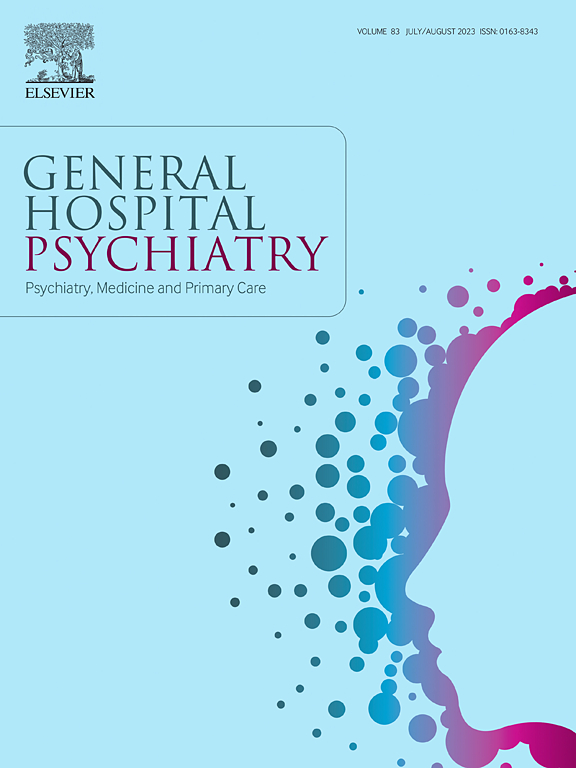躯体症状问卷(PSQ-51)的因素结构探讨。荷兰和英国样本的比较
IF 3.7
2区 医学
Q1 PSYCHIATRY
引用次数: 0
摘要
身体症状问卷(PSQ-51)是一种荷兰语自我报告工具,列出了51种身体症状,这些症状可能出现在患有已知疾病、躯体症状障碍的患者和一般人群中。然而,该工具目前仅提供荷兰语,尚未被翻译或验证为英语,以供英语人群使用。本研究旨在翻译和验证该工具的英文版,并确定PSQ-51在荷兰和英国样本中的因子结构。翻译了英文版本,然后通过反翻译进行验证,并对其进行了改进,以使其清晰。然后分析三个荷兰样本(普通人群[n = 1699],全科医生[n = 775]和精神科门诊患者[n = 1404])和一个英国普通人群样本(n = 294)的数据,以探索因素结构。荷兰精神病学样本的反复探索性因素分析(EFA)揭示了包括症状群的七因素解决方案:全身不适、自主神经、肌肉骨骼、胃肠道、功能丧失、潮热和泌尿生殖器症状。验证性因子分析(CFA)在荷兰和英国的样本中测试了该模型,尽管证明了良好的内部可靠性,但拟合指数的结果好坏参半。研究结果表明,因素结构具有部分跨文化一致性。观察到荷兰和英国人群样本之间症状患病率的实质性差异,可能是由于文化和情境因素。PSQ-51显示了评估躯体症状负担的前景,例如在多病或复杂躯体症状障碍中,它可以通过识别症状来解决临床复杂性,从而加强临床咨询。需要进一步的研究来探索其在不同人群中的适用性,并完善其因子结构以获得更广泛的临床应用。本文章由计算机程序翻译,如有差异,请以英文原文为准。
Exploration of the factor structure of the physical symptoms questionnaire (PSQ-51). Comparisons between Dutch and English samples
The Physical Symptoms Questionnaire (PSQ-51) is a Dutch-language self-report tool listing 51 physical symptoms that may occur in patients with known medical conditions, somatic symptom disorders and the general population. However, the tool is currently only available in Dutch and is yet to be translated or validated into English for utility with English-speaking populations. This study aimed to translate and validate an English version of the tool and determine the PSQ-51's factor structure in both Dutch and UK samples. An English version was translated and then validated through back-translation and refined for clarity. Data from three Dutch samples (general population [n = 1699], general practice[n = 775], and psychiatric outpatients[n = 1404]) and one UK general population sample (n = 294) were then analysed to explore the factor structure. An iterative exploratory factor analysis (EFA) on the Dutch psychiatric sample revealed a seven-factor solution including symptom clusters: General Malaise, Autonomic, Musculoskeletal, Gastrointestinal, Loss of Function, Hot Flushes, and Urogenital symptoms. Confirmatory factor analysis (CFA) tested this model across the Dutch and UK samples, with mixed results for fit indices, although good internal reliability was demonstrated. Findings indicate partial cross-cultural consistency in the factor structure. Substantial differences in symptom prevalence between Dutch and UK population samples were observed, possibly due to cultural and situational factors. The PSQ-51 shows promise for assessing somatic symptom burden, for example in multimorbidity or in complex somatic symptom disorders, where it may enhance clinical consultations by identifying symptoms to address clinical complexity. Further research is needed to explore its applicability in diverse populations and refine its factor structure for broader clinical utility.
求助全文
通过发布文献求助,成功后即可免费获取论文全文。
去求助
来源期刊

General hospital psychiatry
医学-精神病学
CiteScore
9.60
自引率
2.90%
发文量
125
审稿时长
20 days
期刊介绍:
General Hospital Psychiatry explores the many linkages among psychiatry, medicine, and primary care. In emphasizing a biopsychosocial approach to illness and health, the journal provides a forum for professionals with clinical, academic, and research interests in psychiatry''s role in the mainstream of medicine.
 求助内容:
求助内容: 应助结果提醒方式:
应助结果提醒方式:


